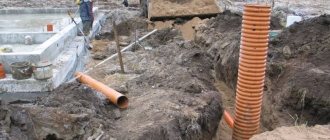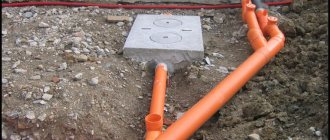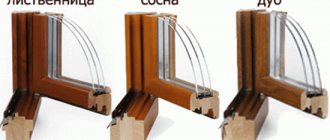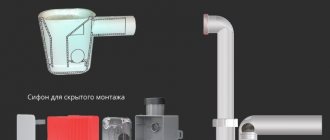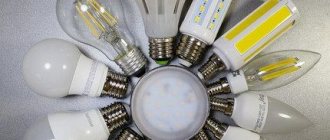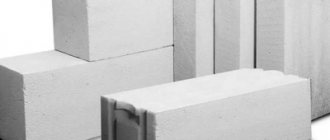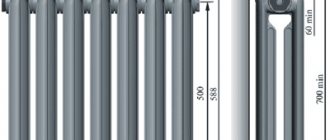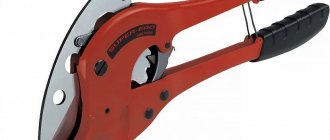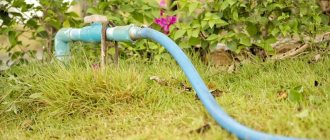One of the advantages characteristic of copper pipes is the relatively simple installation, which can be done with your own hands after a short practice. However, in this case, the main difficulty is not the arrangement of the connections itself, but the selection of elements according to the cross-section and wall thickness.
It should be noted here that such products began to be actively used in the West, which is why instead of the familiar metric system, the inch system is widely used. This is what often confuses inexperienced craftsmen, and therefore, to solve the problem, we strongly recommend studying this article.
The number of typical sections of a copper pipe is measured in tens
No. 1. Steel pipes for water supply
Not so long ago, steel products were leaders in the field of organizing internal plumbing. No one even thought about which pipes for water supply were best to choose - steel ones were installed everywhere. The reason is simple - there were no alternatives. Today, when there is so much to choose from, the popularity of steel pipes has decreased, but there is still a demand for them.
Main advantages :
- low price. Steel pipes are practically the most affordable option for organizing a water supply system;
- high mechanical strength;
- ability to withstand temperatures up to 1000C, sudden temperature changes and pressure rises. That's why it's a universal option that is suitable for both cold and hot water supply.
Minuses:
- low resistance to corrosion, however, applying a zinc coating can somewhat slow down the formation of rust, but over time the protective layer wears off and the corrosion process starts;
- gradual overgrowing of the inner surface of the pipe, resulting in a decrease in throughput and deterioration in water quality. To extend its service life, the system will have to be periodically cleaned of accumulated deposits, but the choice of products should be approached with the utmost caution - alkaline ones, for example, will not work and will only aggravate the situation;
- complexity of installation. Installation is carried out either by welding or using threaded connections. In both cases, you cannot do without the help of a professional, if, of course, you want to get a sealed, reliable water supply system;
- high electrical conductivity of pipes.
With proper care, steel pipes can last about 40-50 years , but today they are used more for the reconstruction of existing water supply systems than for organizing new ones. If your choice falls on steel pipes, then pay attention to the thickness of the walls: there are light, ordinary and reinforced pipes. The thicker the wall, the more durable and reliable the product will be.
Recently, pipes have appeared on the market in which the inside is made of plastic. In a similar way, the problem of corrosion and overgrowth was solved while maintaining the strength properties of the steel. Such pipes have a somewhat limited scope of use - they are suitable only under the condition of a maximum temperature in the system of 750C and a pressure of 16 atm.
Size chart
Main sections and translation technique
As we noted above, most often the pipe cross-section is indicated in fractions of an English inch. This is difficult only at first glance, because once you figure it out, you can literally “on the fly” convert these values, selecting a part in accordance with the task.
Wall thickness is also an important parameter
The calculations are quite simple:
- So, the value of one inch is approximately 25 mm (actually 25.4 mm, but such accuracy is needed only in very rare cases).
- Now, to find out, for example, the diameter in mm of a copper pipe of 1 4 inches, we multiply 25 by 1/4. As a result, we get a value of 6.25 mm.
Advice! In this way, only an approximate value can be obtained, since deviations are usually explained by different wall thicknesses for different sizes. However, this accuracy is enough for everyday needs.
Half-inch pipe with fitting
The complete table of copper pipe diameters is given below:
| Section, inches | Outer diameter, mm | Wall thickness, mm |
| 1/4 | 6,4 | 0,6 |
| 3/8 | 9,5 | 0,7 |
| 1/2 | 12,7 | 0,9 |
| 5/8 | 15,9 | 1,02 |
| 3/4 | 19,05 | 1,02 |
| 7/8 | 22,2 | 1,1 |
| 1 1/8 | 28,6 | 1,3 |
| 1 3/8 | 35,0 | 1,4 |
| 2 1/8 | 54 | 1,78 |
| 2 5/8 | 66,7 | 2,03 |
| 3 1/8 | 79,4 | 2,5 |
| 4 1/8 | 104,7 | 2,8 |
Note! Sometimes the pipe marking does not indicate inches, but the cross-section and wall thickness in millimeters. For example, a 6x1 copper pipe has a diameter of 6 mm and a wall of 1 mm.
Product with a cross section of 6 mm with a millimeter wall
Product weight
Knowing these data, you can quite easily calculate the mass of a linear meter to calculate the load on supporting structures:
M = (D - S) * S * 3.14 * p/1000, where
- M – specific gravity of the pipe (kg/m.m).
- D – outer diameter, mm.
- S – wall thickness, mm.
- P – copper density, 8.9 g/cm3.
Therefore, if we have a copper pipe 1 1 8, then:
M = (28.6 – 1.3) * 1.3 * 3.14 * 8.9/1000 = 752 g/m.
As in the case of the cross-section, the figures are quite approximate, but they are quite sufficient to assess the situation.
Use of pipes of different diameters
The range of applications for copper products is quite wide:
- Copper pipe 10 mm or less is used for installation of internal heat exchangers in heating and air conditioning systems. The small diameter of such pipes ensures maximum operating efficiency of such devices due to good energy transfer.
- Products from 10 to 25 mm are used for installation of water pipelines. 1 2 inch copper pipe is one of the most commonly used pipes when installing a water supply system. The same goes for 3/4″ parts.
Use in the manufacture of convectors
- Varieties up to 40-45 mm are used for drainage systems. Despite their relatively small diameter, they provide effective drainage due to their high permeability.
- Copper pipe 3 8, as well as thicker varieties, are also well suited for heating systems. The high heat resistance of the material, together with the excellent thermal conductivity of thin walls, allows you to heat a room with minimal energy consumption.
- The thickest pipes are used for laying branches from water-carrying mains, as well as decorative and protective elements, for example, casings for semi-open wiring.
No. 2. Stainless steel pipes
To obtain a corrosion-resistant material, steel is alloyed mainly with chromium. “Stainless steel” looks great and has outstanding performance qualities. It is as durable as pipes made of ordinary and galvanized steel, withstands changes in pressure and temperature, and is not afraid of shocks. Moreover, such pipes are not afraid of corrosion , so the upper limit of durability exceeds 50 years. Among the main disadvantages is not even the complexity of installation, but the high cost of the material, which is why stainless steel pipes are used extremely rarely today, although they are excellent for hot and cold water supply systems.
Flaws
Minuses:
- The highest cost among analogues.
- The assembly technique is much more complex than, for example, soldering polypropylene.
- Due to their high thermal conductivity, it is recommended that such pipes be laid in insulating sleeves (foamed), as this will allow heat to be delivered to heating devices with minimal losses.
No. 3. Copper pipes
Usually, they try to hide the water supply system in an apartment from view in every possible way, because there is little attractive in pipes and all kinds of fittings. This is true, but not in the case of copper pipes. They boast a unique appearance , so they can easily decorate a retro-style interior. Appearance is not the only advantage of this type of pipe, among other advantages:
- high resistance to temperature deformation;
- durability up to 70 years;
- resistance to high temperatures and increased pressure in the system;
- corrosion resistance and less tendency to overgrow compared to steel pipes;
- Completely safe for health, as no hazardous compounds are formed when chlorine interacts with copper. Moreover, copper pipes have a disinfecting effect and rid water of pathogenic bacteria. Unlike steel, copper does not spoil the taste of water.
Among the disadvantages :
- high price and small range. Everything that is on the market today is mainly products of foreign manufacturers. In addition, there are problems with finding the necessary fittings for installing pipes;
- complex installation using soldering;
- low mechanical strength
If you choose which pipes for water supply are better, then copper ones can easily compete for the title of winner, but their high cost still does not allow them to become a leader in this area. Where hidden installation of water supply is not possible, copper pipes can be a very good option.
Conclusion
Using the information presented above, you can quite easily determine the diameter in mm of a 1 2 inch copper pipe, calculate the specific gravity of such a product, and understand whether it is suitable for the task facing us. However, over time, the skill will appear, and you simply won’t have to do the calculations.
In order for this skill to develop faster, we recommend that you apply the acquired knowledge in practice more often, and carefully study all available additional information, first of all, the video in this article.
Did you like the article? Subscribe to our Yandex.Zen channel
No. 4. Metal-plastic pipes
Looking ahead, we note that metal-plastic pipes are an excellent option for organizing water supply for a summer house or private home . The product has a multilayer design: around a layer of aluminum foil there is an outer and inner layer of plastic. They are fastened together with strong glue. The metal layer provides the necessary strength, and the plastic provides lightness, flexibility, and resistance to corrosion and overgrowth.
Advantages:
- low price;
- durability about 35 years;
- corrosion resistance;
- mineral deposits do not accumulate inside such a pipe, so there is no need for regular cleaning;
- light weight. A pipe 10 m long and 30 mm in diameter weighs about 1-2 kg;
- simple installation, which is carried out using press fittings and a wrench - no welding;
- flexibility and ability to maintain shape;
- dielectric outer shell.
Minuses:
- From time to time you will have to tighten the threaded connections, so it is necessary to ensure easy access to them. The reason that the joints weaken is simple - aluminum contracts more than plastic when the temperature changes;
- connecting elements do not have a budget price;
- not the best strength of the joints, and even the pipes themselves.
Metal-plastic can withstand temperatures up to +950C at a pressure of 10 atm . The pipes will maintain their integrity with a short-term increase in temperature to +1100C at constant pressure. The material will also withstand pressure increases of up to 25 atmospheres at temperatures up to +250C.
To equip a cold water supply , you can take blue and light blue pipes - they are adapted to operate at water temperatures no higher than +350C and are cheaper than white pipes, which can be used to transport hot water . This is a very good option for a dacha and a private house, but for an apartment building you can choose more suitable pipes.
Combinations of colors and materials
Copper products, sheets and panels can have different shades - from bright red to soft pink. Under the sun's rays they glow red, orange, and yellow. The palette of shades for interior decoration should be selected based on specific conditions, the location of the apartment, and the brightness of lighting during the day and evening.
Copper works best when combined with finishes in muted tones:
- black;
- brown;
- blue;
- emerald;
- white;
- olive;
- turquoise;
- graphite.
These shades in combination with copper are ideal for apartments decorated in retro and eco-styles. Light wooden furniture with copper frames or fittings looks no less beautiful.
When it comes to textures and materials, copper pairs perfectly with other metals, especially brass. It also emphasizes the respectability of the room, decorated with plaster, luxurious wallpaper, glass, crystal stained glass, and expensive tiles.
No. 5. Polyethylene pipes
Pipes made of polyethylene, polypropylene and polyvinyl chloride are often combined into the general group of plastic pipes. Despite the similarity of some characteristics, each of these materials has a set of unique properties, and we will begin by considering polyethylene structures.
Let us note right away that it is necessary to separate pipes made of low-density polyethylene and cross-linked polyethylene. They are characterized by temperature resistance. The former can withstand temperatures of no more than +400C, are suitable for organizing cold water supply, and are often used to transport water from a well to a private home, since they are not afraid of frost and do not burst when water freezes.
Pipes made of cross-linked polyethylene can be used in a hot water supply system, but they are also more expensive. No rubber seals are used for installation - the required degree of tightness is achieved by crimping the fitting with a pipe.
A number of experts call cross-linked polyethylene pipes the best option for organizing water supply. They are resistant to corrosion, do not overgrow, are inert to all substances contained in water, and allow you to create strong connections. The disadvantages are not the lowest price and the need for special equipment for installation.
Application options in the interior
Copper can be introduced into the interior in a variety of ways - from full-fledged wall decoration to accent use in the form of ribbons, accessories and small details.
Surface decoration
Metallized wall cladding is an original way to radically change the interior, making it catchy and effective. Copper-based or copper-plated materials are now at the peak of popularity.
Thin sheet panels are most often used. They decorate the lower part of wall surfaces or make an accent wall in living rooms and dining rooms.
Another option for wall decoration is the use of copper mosaic. Typically, this material is used to cover a kitchen apron and looks especially interesting in combination with copper utensils.
For small kitchens, mosaics with a shiny surface that beautifully reflect light are more suitable. Copper sheets are also used to cover the floor, ceiling beams and doors. A metal spiral staircase or a colorful stained glass window made of glass and copper looks original.
Copper furniture
Such furniture would be appropriate in styles that involve rough finishing and the use of natural materials. Real art objects are made from golden metal: tables, bedside tables, chests of drawers, beds, bar stools, elegant armchairs. The material combines well with glass and wood and serves as a raw material for the manufacture of fittings, legs and other furniture parts.
Copper facades for the kitchen
Lighting devices
Lamps made of copper look interesting and original, immediately bringing sophistication, shockingness and rich color to the room. They are in harmony with other copper elements or with copper trim on walls, floors, and ceilings.
In the collections of fashionable lighting fixtures you can find metal chandeliers, original sconces, floor lamps, light bulbs in unusual copper sockets. For interiors in the loft style, you should choose rough, massive lamps; for a retro style, round pendant products or fancy models.
Copper plumbing
The copper bathtub in the center of the room is a luxurious accent and an incredibly convenient, comfortable device for water treatments. Copper faucets, bowls, and sinks also look beautiful and last a long time, which over time become covered with patina and acquire an aged “appearance.”
Important! Copper is used to make table tops, bathroom furniture handles, robe hooks, and heated towel rails.
Bathtub and sink made of copper
Accessories and household items
To update your interior, you don’t have to spend huge sums on decorating the walls with copper panels. You can successfully integrate correctly selected details and elegant decorative elements into the decor, and the design will sparkle with new colors.
The most popular copper accessories are:
- mosaic panels;
- vases;
- trays;
- candlesticks;
- frames for mirrors and photos;
- watch;
- flower pots;
- hoods;
- clothes hangers;
- umbrella stands;
- key holders;
- decorative plates.
Large round mirror with copper frame
No. 6. Polypropylene pipes
Polypropylene pipes are actually an ideal option for organizing water supply . Can be unreinforced or reinforced . The former are suitable only for cold water supply, the latter are used for both heating and hot water supply. The pipe can be reinforced with aluminum, fiberglass or other materials. Reinforcement increases strength and reduces thermal elongation of polypropylene. The best option is fiberglass reinforcement.
Polypropylene pipes for water supply
Today, the highest quality reinforced pipes are produced in Germany. Detailed technical characteristics and a list of objects where such pipeline systems are installed can be found on the website of the representative of the German plant aquatherm GmbH - Agpipe Group of Companies: https://agpipe.ru/plastikovie_trubi_dlya_vodoprovoda/polipropilenovie_trubi_dlya_vodosnabzheniya
Advantages of polypropylene pipes:
- durability up to 50 years;
- the ability to withstand temperatures inside pipes up to +90-950C and pressure up to 20 atmospheres (this applies to the reinforced version);
- relatively easy installation. The pipes are connected using a special welding machine for polypropylene. Working with it is not difficult; it will take a little time to learn and bring the process to automation;
- strong connections;
- such pipes will even withstand freezing of water inside them;
- corrosion resistance;
- sufficiently high strength;
- relatively low price
Among the disadvantages is the fear of high external temperatures, so this is not an option for fire hazardous areas. In addition, even when reinforced with aluminum or nylon thread, the material retains a high level of thermal deformation, so the use of insulation for hidden pipe routing, or compensators for open routing, is indispensable. If you weigh all the pros and cons, then it is better to choose polypropylene pipes for water supply at home.
No. 7. PVC pipes
PVC pipes are used only for cold water supply, can withstand temperature surges up to +650C , pressure up to 16 atmospheres , are often used for supplying water to the house, but rarely for internal wiring.
Among the advantages :
- resistance to aggressive environments;
- low weight;
- resistance to corrosion and overgrowth;
- fire resistance;
- durability about 50 years;
- Relatively simple installation; high tightness of connections.
Among the disadvantages , in addition to instability to high temperatures, it is worth noting the sensitivity to scratches and the difficulty of disposal.
